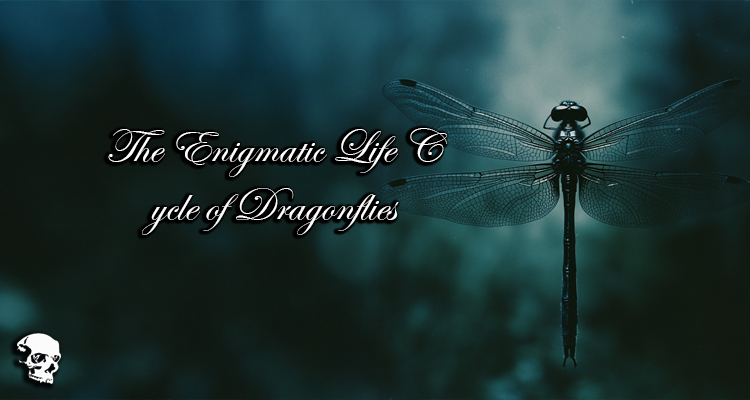Currently Empty: $0.00

The Enigmatic Life Cycle of Dragonflies
Dragonflies, with their haunting elegance and ancient lineage, captivate us with a life cycle both ethereal and grounded. Their journey encompasses aquatic depths and terrestrial skies, a metamorphosis steeped in mystery and transformation. This article explores the distinct stages of their existence, reflecting their resilience and their connection to the world’s shifting environments.
The Beginning Beneath the Surface: Egg Stage
The dragonfly’s life begins humbly, in the still or slow-moving waters of ponds, marshes, and streams. Female dragonflies lay eggs on submerged vegetation or directly into the water. These eggs are tiny capsules of potential, housing the beginnings of an extraordinary creature. Depending on the species, the eggs may hatch within days or linger dormant for weeks, awaiting the right environmental conditions.
Water temperature and oxygen levels play pivotal roles in determining the timing of hatching, a delicate balance that ties these creatures to the rhythm of their surroundings. For some dragonflies, their eggs can even withstand periods of drought, a testament to their evolutionary adaptability. As these eggs burst open, they give way to an unassuming aquatic lifeform: the nymph.
A Predator Lurking Below: Aquatic Nymph Stage
The nymph stage is where dragonflies spend most of their lives, hidden in watery realms. Resembling a shadowy monster more than a future winged marvel, the nymph is a voracious predator. It feeds on tiny aquatic creatures, from insect larvae to small fish, showcasing a predatory cunning that sets it apart. Equipped with extendable jaw-like appendages, nymphs strike with eerie precision—a trait that hints at their future aerial hunting prowess.
This stage, lasting months or even years, is punctuated by multiple molts. With each shedding of their exoskeleton, the nymph grows larger, inching closer to their next dramatic transformation. Their survival is intricately tied to water quality and temperature, making them sensitive indicators of environmental health. Beneath the ripples, the nymph is an unsung sentinel of ecosystems—a silent guardian amid murky depths.
The Moment of Transformation: Metamorphosis and Emergence
When the time comes, the nymph climbs out of the water, driven by an ancient instinct to seek higher ground. The act of emergence is both a transformation and a rebirth. Anchored to reeds or rocks, it sheds its aquatic exoskeleton to reveal a fragile, crumpled dragonfly. This metamorphosis is a vulnerable time, as the insect waits for its wings to harden and body to strengthen.
The moment is almost ritualistic, a tribute to resilience and renewal. For hours, the dragonfly remains in stillness, preparing for a life above the surface. This dramatic shift—from aquatic hunter to aerial predator—is marked by a quiet intensity. When their transformation is complete, they take to the skies, carrying with them the echoes of their watery beginnings.
The Aerial Apex: Adult Stage
As adults, dragonflies become masters of the air, their movements swift and deliberate. Their sleek, veined wings cut through the sky, their compound eyes providing nearly 360-degree vision. With deadly precision, they hunt flying insects, ensuring that even their final chapter remains predatory. Dragonflies are ephemeral in their aerial stage, living only a few weeks to months.
During this time, they focus on reproduction, their courtship rituals a display of acrobatic elegance. Some species exhibit vibrant, metallic hues that shimmer in the sunlight, while others exude darker tones, embodying a shadowy grace. As they mate and lay the next generation of eggs, they complete the cycle of life—a fleeting existence that leaves an indelible impact on their ecosystems.
The Silent Guardians of Ecosystems
Dragonflies are more than ancient creatures of beauty; they are critical players in maintaining the health of aquatic and terrestrial habitats. Sensitive to environmental changes, they act as ecological barometers, their life stages deeply intertwined with the balance of nature. Rising temperatures, habitat loss, and pollution disrupt their delicate existence, serving as warnings of broader environmental shifts.
As both predator and prey, dragonflies hold an important place in the food web, controlling populations of insects like mosquitoes while providing sustenance for birds and amphibians. They embody a harmonious duality—both delicate and fierce, ancient yet adaptable. Their story is one of survival and transformation in a world ever in flux.
A Dance Between Two Worlds
The dragonfly’s life cycle is a poignant reminder of life’s transient beauty and resilience. From their beginnings as water-bound predators to their final flight as ethereal hunters, they bridge two realms with haunting elegance. Their existence whispers of change, adaptability, and the fragile threads that connect us to the natural world. For those attuned to life’s subtleties, the dragonfly is both an emblem of transformation and a harbinger of the ecosystems we share.
Are you enjoying this article or our site? Love of Gothic and the Dark Matters & Mischief magazine are run by dedicated volunteers, and we rely on crowdfunding to cover our expenses. Your support is crucial to keep us going! Consider becoming a paying member of our Patreon or purchasing something from our shop to help us continue providing content and community support. Thank you for your support!

